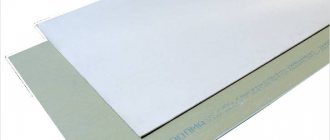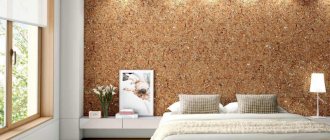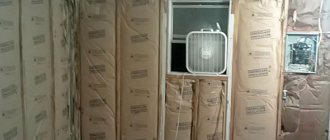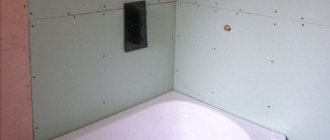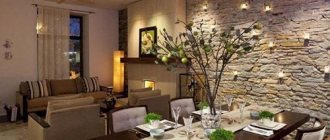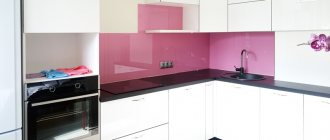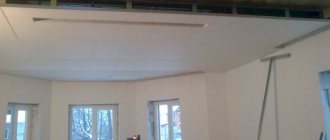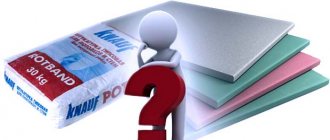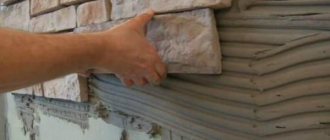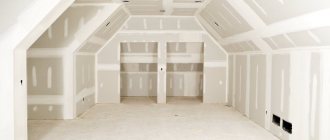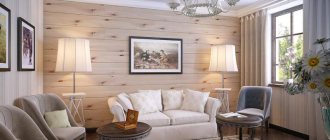Covering walls with plasterboard for leveling and preparing for finishing is increasingly replacing traditional starting plaster. This is what drywall was invented for: its synonym, as you know, is dry plaster. Firstly, leveling walls with plasterboard is much simpler and cheaper than old-fashioned plastering. Especially wooden walls: to plaster wood using the Old Testament method, you must first apply glassine to the wall, then felt soaked in liquid clay mortar and a 2-level sheathing of shingles. Secondly, the most experienced plasterer, working with a falcon and a trowel, will not create a plaster layer that is smoother than 3 mm/m. The plaster itself, when drying out, will give more unevenness, because... applied in spots. Meanwhile, for many modern methods of decorative wall finishing, 3 mm/m is the limit.
Sheathing with plasterboard allows you to bring the wall up to a general unevenness of 2 mm between the diagonal corners. In addition, plasterboard sheathing has a mark in front of solid plaster. advantages:
- Hygienic and hypoallergenic - does not create dust and does not get dirty.
- Improves the heat and sound insulation of housing.
- “Breathes”, i.e. absorbs excess water vapor from the air and releases it when there is a deficiency; this is especially important in an apartment in a building made of reinforced concrete or sand-lime brick. The breathing of drywall is not as deep and even as wood, but still not stone.
Covering a room with plasterboard
There are only 2 disadvantages to leveling walls with plasterboard, but they are quite serious.
The first is fragility. If the corner of the furniture hits a wall plastered in the usual way, a pothole is possible, which is easy to repair. If a stumbled or slipped person presses his body against such a wall, nothing will happen to it at all. In both cases, drywall is at risk of breaking and cracking.
The second is the poor accessibility of hidden communications. If a pipe leaks in an ordinary wall or the wiring burns out, the problem will be solved with a groove, which is subsequently sealed. If there is an accident behind the drywall, you will have to remove at least one slab, ruining the final finish until it needs to be completely replaced.
Taking into account all these circumstances, the question needs to be decided: ordinary starting plaster or drywall. In modern budget and mid-level housing, the result is most often in favor of the latter due to the low cost and ease of work. Therefore, the purpose of this article is to give the reader as complete an idea as possible of how to sheathe and level walls with plasterboard with your own hands, because covering a room with it approx. 12 sq. m by hired craftsmen costs somewhere from 30 thousand rubles, the popularity of the material affects pricing.
Material
Drywall is a pressed mass of cellulose filler with a gypsum binder, covered with a protective paper layer. It is produced in sheets (gypsum plasterboard), up to 16 mm thick, and slabs (gypsum plasterboard) up to 32 mm thick. For cladding walls and ceilings, regular gypsum plasterboards, moisture-resistant green gypsum plasterboards, fire-resistant gypsum plasterboards in red or orange, and fire-moisture resistant gypsum plasterboards in green with a red stripe are used.
GKLO and GKLVO are used for finishing wooden buildings, because in case of fire, they delay the spread of flames for a time sufficient to evacuate people. All types of gypsum plasterboards and gypsum boards are intended for internal use only, because cannot withstand prolonged exposure to outdoor conditions. GKV is resistant in rooms with high humidity and occasional splashing (bathroom, hallway, basement, garage), but not in rain and wind.
Data on the main standard sizes of gypsum boards
The parameters of the most commonly used standard sizes of gypsum boards are given in the table, but in trade practice they are often divided more simply: into arched ones with a thickness of up to 6.5 mm, ceiling ones with a thickness of 9.5 mm and wall ones with a thickness of 12.5 mm (all - including paper covering). Arched plasterboard is intended for the manufacture of three-dimensional decorative structures, but can also find auxiliary use when covering walls, see below. Ceiling gypsum plasterboards of lighter weight, as the name implies, are sheathed on ceilings.
Sealing seams
Before finishing is carried out, it is necessary to putty the seams or seal them with sickle. Without this, plasterboard sheathing will not be reliable.
Operating procedure:
- joints are removed from dust and dirt;
- if there are no indentations at the points of contact, they are made with a construction knife;
- the joints are taped;
- Putty is applied to the recess and leveled.
Basic cladding methods
Wall finishing with plasterboard can be done framed (over lathing), frameless with glue, or combined . The latter is equivalent in all properties and qualities to frameless, so they are often not separated. The advantage of frameless gypsum board cladding is the extreme simplicity and low cost of work. It also has less impact on the fragility of drywall due to its larger adhesion area to the load-bearing (base) wall. The disadvantage is that the stability of the entire cladding depends on the condition of the base wall: if it gets wet or otherwise loses its surface strength, a sudden collapse of the entire cladding is possible at once. Also, gypsum plasterboards cannot be placed on wooden walls using glue. In principle, it is possible that adhesives such as aquarium silicone or Moment-gel hold gypsum plasterboard on wood equally well and never show spots on the sheathing. But the cost of finishing will be such that mahogany lining is unlikely to cost more. Therefore, further attention will be paid to gypsum board sheathing on the frame, as it is more expensive, but reliable and allows for insulation of the room from the inside.
Note: some consider an additional advantage of gypsum plasterboard sheathing on the frame that it can be done without stripping the base wall, i.e. on old plaster and wallpaper. But, firstly, this cannot be done for sanitary and hygienic reasons. Secondly, without a technical assessment of the condition of the main load-bearing surface, there can be no confidence in the reliability of the entire skin.
Necessary tool
Facing
Laying plasterboard walls over a metal frame is impossible without special equipment. If you want to plaster just one wall in a room, it will take very little time, so you can rent a tool or borrow it from your neighbors.
You will need:
- A hammer drill with a drill diameter that matches the diameter and length of the dowels; you can use a drill with an impact mechanism.
- Screwdriver with a Phillips bit.
- Building level at least 60 cm long.
- Roulette.
- Rule.
- Plumb.
- Pencil or marker, marking thread.
- Stepladder or scaffolding.
- Hammer, screwdriver, construction knife and a set of replacement blades.
- Metal scissors – necessary for cutting the profile to the required length.
- Thick strong long thread.
GKL on a frame
The technology of cladding gypsum board walls on a frame is based on the use of thin-walled galvanized steel profiles. Wooden sheathing has now completely outlived its usefulness, even on partitions in heated rooms: due to thermal deformations and warping of the wood, cracks creep along it after 3-4 years. GKL sheathing on a wooden frame is suitable for small elements of volumetric structures, sheathed in pieces without seams. GKL sheathing on a steel frame includes the following. stages of work:
- Preparation of the wall and existing communications;
- Selection of frame design, profiles and fasteners to it;
- Measuring the unevenness of the load-bearing wall, marking for the frame, cutting and cutting gypsum boards;
- Frame installation;
- Attaching the gypsum board to the frame;
- Grouting;
- Installation of skirting boards covering gaps.
Wall
You need to remove the old finish from the wall under the gypsum plasterboard covering. Electrical wiring is laid in grooves; the pipes are surrounded by a frame using crossbars (see below), because It is unacceptable to make slots for communications in the frame profiles.
Profiles
To cover the wall you will need profiles of the standard sizes shown in Fig. Sometimes the so-called hat profile (see below). Shaped finishing profiles are most often used for cladding gypsum board slopes, but this is a special issue, much more complex than cladding walls; craftsmen charge $30-$100 for 1 slope, depending on its size and complexity.
Profiles for drywall
Note: PS rack profiles are sometimes called wall profiles, and PN guides are sometimes called wall profiles.
Frames
A typical scheme for covering a gypsum board wall on a frame made of PN, PNP and PS profiles is shown in the following. rice. Suitable for most types of stone walls, also in a wooden house made of laminated veneer lumber, because it practically does not warp or “play” due to temperature changes. Suitable for internal insulation and double skinning (see also at the end). Using standard lathing, you can sheathe the walls of the GKP.
Typical scheme for covering walls with plasterboard
Sheathing using flat profiles (see next figure) is much cheaper than standard cladding, but is only permissible in dry, heated rooms. For wooden laths you need to use seasoned timber 75x50, chamber dried. If the general unevenness of the wall is up to 10 mm, and the local unevenness is up to 3 mm/m, the flat profiles can be attached directly to the wall (see also below, about fasteners for the frame). Sheathing along flat profiles is possible using scraps or pieces of gypsum boards staggered, as well as horizontally oriented sheets. This can be significant if the height of the room (for example, 3.6 or 2.4 m) does not fit well with the length of the gypsum board sheets. It is not recommended to do double cladding on flat profiles.
Wall covering with plasterboard using flat profiles
Finally, there may be a case when the thickness of the cladding together with the frame is required to be minimal , for example, in tight spaces. Then it is possible to make lathing for gypsum plasterboards only from ceiling profiles (next fig.), but double and single gypsum plasterboards with a thickness of over 14 mm and gypsum plasterboard frame will not withstand ceiling profiles. The recommended thickness of gypsum plasterboard for installation on a frame made of ceiling profiles is up to 10 mm. The same type of frame can also be assembled only from PS profiles, but it will turn out to be just as weak, but of full standard thickness.
Wall covering with plasterboard on ceiling profiles
Note: the sealing and damping tape in all cases is made of microporous rubber or a similar material with a thickness of 4-6 mm.
Fasteners
There is a wide range of fasteners for sale for frames under gypsum boards, but a direct hanger (pos. 1 in the figure below) can be considered universal, especially since straight hangers can be doubled, pos. 2; the “whiskers” sticking out forward are bent to the side. This allows you to mount a frame with the possibility of insulation on walls with potholes/bumps up to 40-50 mm. The mounting legs of direct hangers can be bent back for mounting exactly on a corner or wooden stand (see below). Direct hangers are attached to the wall with self-tapping screws in propylene dowels with the threaded part entering the wall, at least:
- Concrete – 70 mm.
- Made of red solid brick – 80 mm.
- From silicate and red hollow bricks – 90 mm.
- Wooden – 100 mm.
- From foam concrete, aerated concrete, PHB - 120 mm.
Fastening and corner connection of drywall profiles
It is unlikely that any frame for gypsum plasterboard will do without crossbars to bypass openings, communications and assemble additional load-bearing beams at the joints of sheet chords. The cross members are cut from the same profile as the vertical posts of the frame. For mounting them, there are corner hangers on sale, but most craftsmen do without additional fasteners. If you cut through the corners of the profile, as in pos. 3a, then we get 3 mounting paws, pos. 3 b. But it is unacceptable to attach the cross members to the racks with an overlay (pos. 3c) in loaded structures: the screw heads will become sources of dangerous local stresses in the casing. Sometimes the middle leg is cut out (pos. 3c), the side ones are bent, and the crossbars are attached flush, but the knot turns out to be rather weak. It would be correct to trim the middle paw and place it on top of the vertical post, pos. 4. When installing the skin, a self-tapping screw will cut into it, the sheet of skin will be pressed, and the entire fastening unit will be very reliable.
What to fasten with?
Since we had to touch on the issues of assembling the frame and fastening the sheathing ahead of time, it must be said that the frame is assembled using LN9 metal self-tapping screws (with a press washer head), and the gypsum board is attached to the frame with TN25 self-tapping screws. The head of the latter is not conical! It smoothly transitions into the body of the propeller! If you attach gypsum boards with screws with tapered heads, the sheathing will not last long, see also below. Installation holes for self-tapping screws are punched in advance with a special profile cutter, see fig. If you simply drill them, then a skirt will not form for threading, and the screws will not hold at all.
Profile cutter for drywall
Marking for the frame
By cleaning the wall with a long, even strip - the rule (emphasis on the “and”) - is to determine its overall unevenness; The choice of frame layout may need to be changed. Then find the height of the most protruding mound. After this, a line is struck on the ceiling, perpendicular to the adjacent walls and spaced at least 20-30 mm from the level of the top of the highest hillock of the sheathed wall. From this line, another line is drawn along a plumb line on the floor; In this way, the alignment of frame parts is greatly simplified.
Next, starting from the corner along a plumb line, vertical lines are struck in increments of 600 mm so that they fall exactly on the joints of the sheets. It is also necessary to take into account that gypsum board sheets should be 20-30 mm away from adjacent walls, floors and ceilings. That is, the first line is marked at 620-630 m from the corner, the next at 1220-1230 mm, etc. The last line should be the same 20-30 mm from the final corner plus half the installation width of the profile, i.e. by 80-90 mm.
The next step is to make a mark on the vertical lines 80-90 mm from the floor and the next in increments of 600 mm until less than 600 mm remains to the ceiling. Then the last vertical marks are also made 80-90 mm from the ceiling. A direct suspension is applied to the vertical marks in turn and the places for drilling holes for self-tapping screws in the wall are marked. If there are not enough standard sheets in height for a given room, in a similar way, but now level, mark the wall for installation of crossbars. Don’t forget, the longitudinal axis of the cross member profile should also be at the junction of the slabs of the sheathing chords! That's all for now, you can get distracted by marking and cutting the gypsum boards.
Preparation of gypsum boards
Edge plane for drywall
At this stage of the work, you first need to cut the incomplete sheets to size. Cutting plasterboard is simple: cut with a mounting knife, break in weight, cut from the inside, see fig. below. “From the inside out” is conditional, both layers of gypsum board are the same. Next, chamfers are removed from the edges of the sheets for grouting the joints. To do this you will need a drywall edge plane, see fig. on right. If you have a one-time job for yourself, then it is better to rent it, because... This tool is not suitable for anything else. You need to take a plane for 2 angles - 45 and 22.5 degrees; why - see below, about grouting joints.
How to cut drywall
Note: you need to cut the last sheet along the row (belt) to the width of approx. 10 mm narrower than what was measured. The fact is that for thermal deformation of the sheets themselves, you need to give a gap of 1-2 mm between them. On a wall of normal length there will be about that much. You can take this value into account when marking the wall for the frame, but there will be a lot of fuss, and a profile width of 60 mm on a regular wall is enough to compensate for the discrepancy.
The next point is marking and drilling/cutting holes and openings for sockets, lamps, pipes, ventilation, etc. To do this, it is convenient to use a sheet of ordinary packaging cardboard 600 mm wide: it is applied to the wall, pressed over the recesses with the palm of your hand, the contours are outlined with a pencil, cut out and transferred to the gypsum board. Holes in drywall are cut with a pen or compass drill, and rectangular openings are cut with a drywall knife. It is similar to the mounting one, only its blade is thicker and stronger.
Frame assembly
Installation of guide profiles for drywall
Installation of the frame for gypsum board cladding begins with the installation of guide profiles on the floor and ceiling. If adjacent walls are not sheathed, PN profiles are also placed on them to create a solid frame, see fig. on right; connecting its corners - on each side with a TN9 self-tapping screw (so that the head does not protrude). The first attachment points to the floor/ceiling are 60 mm from the edge; the rest - in increments of approx. 300 mm so that the last one is also 60 mm from the other edge.
Next, straight hangers are attached to the wall, the PS/PP profiles are inserted into the PN/PPN (first at the bottom, then at the top), move them to place and check their evenness horizontally and vertically using a rule and a plumb line or a level in which there is a tube for plumbness. If prev. the work was carried out carefully, no additional alignment will be required. Then the “whiskers” of direct hangers are bent to the rack profiles and the profiles are attached.
Two-level profile connector for plasterboard
The next stage is the installation of crossbars. How it is done is described above, but sometimes, say, when laying pipes running along a wall, a second level needs to be added to the frame. This is done using 2-level crabs, see fig. left. It may also be necessary to assemble the crossbars from pieces, because they will be used for cuttings. Assembling rack and guide profiles from pieces is only permissible as a last resort!
The profile sections are connected end-to-end using straight connectors, pos. 1 and 2 in Fig.:
Connecting profiles for plasterboard end-to-end and crosswise
In critical places, for example, in the lining of door openings, windows and mortgages for hanging furniture and equipment, it is highly advisable to connect crossbars with racks not in a simple way, but with the help of special crosses, so-called. single-level crabs, pos. 3 and 4.
Connecting profiles for plasterboard end-to-end and crosswise
In the end you should end up with something like the one in Fig. on right.
Angles
In the case where all walls are covered with plasterboard, special attention should be paid to lining the corners. There are usually no internal problems; Schemes for lining internal corners for cladding on a frame and combined with glue (see below) are given in pos. 1 and 2 next rice. By the way, over the past year and a half, Knauf gypsum boards have become completely disgraceful: everything is in bubbles, soft, like foam, you can pierce it with your finger. Not counterfeit, original.
Lining corners with plasterboard sheathing
With external corners it is more difficult. You cannot place them on the edges along the rack; 2 sheets at once will end up with hanging edges, which is unacceptable. The stand needs to be placed on one side of the corner, a hanging profile of the same type must be attached to it, and the edges of the gypsum board should be attached to it, pos. 3. Then a PU profile using Fugenfüller glue or similar is applied to the joint of the sheets, pos. 4. It is better to take PU with reinforcing mesh, pos. 5.
The PU protrudes above the gypsum board by 2-2.5 mm. This protrusion must be reduced to the general level of the skin at a width of 400-500 mm, then it will not be noticeable and will not interfere with any finishing. Smooth out the PU protrusion with gypsum starting putty and a spatula, respectively. width.
Insulation under the skin
Scheme of wall insulation under plasterboard sheathing
Generally speaking, insulating from the inside is bad: there is a high probability of dew point getting inside the room. It is strongly recommended to lay insulation under the gypsum board sheathing only if the wall is already insulated from the outside. In this case, insulation under the gypsum board cladding of the concrete wall is done according to the scheme in Fig. on right. If the wall is brick or wooden, before installing the frame, a semi-permeable waterproofing membrane is applied to it, the same as is used for thermal insulation of roofs: it will not allow water to pass through, but will release its vapor. The best option is a microperforated membrane.
Instead of penofol, you can use folgoizol or a similar vapor barrier. It is applied to the frame before installing the sheathing with a continuous layer of foil inside. The overlap of the edges of the vapor barrier tapes is from 15 cm; The joints are taped with construction tape. The edge flaps on the floor, ceiling and walls are the same; the excess is trimmed off after installing the skirting boards. If there is no external insulation yet, then it is necessary:
- The sheathing is made from gypsum boards.
- The insulation should not be mineral wool, but cellulose insulation (ecowool), it does not fall off and retains its insulating properties when wet. True, ecowool will cost approx. 25% more expensive.
- Before installing the frame, apply a microperforated membrane to any wall.
Sheathing
To mark the holes for attaching the gypsum board to the frame, pioneer holes of approx. 2 mm in diameter, I place the sheets in place and use a mechanic’s scribe to mark the places of notches on the profiles. The distance of the sheet from the floor of 20-30 mm is ensured by scraps of wooden slats. Mark them and don’t lose them, otherwise the holes won’t fit together later!
The number of attachment points is 45-70 per sheet with a length of 2000-3000 mm, respectively. There are 5 points on the short sides (3 on the racks and 1 between them); the rest are evenly distributed along the long sides and along the center line. The extreme points should be 9-12 mm from the edge of the sheet.
An important point when attaching gypsum boards to the frame is screwing in the screws. The screwdriver must be set at minimum speed so that the head of the screw just presses into the cover paper without tearing it, as in pos. 2 fig. In other cases, the fastening will be weakened by 1.5-1.8 times, and if it is not screwed down enough (item 1), then the protruding fastener heads will weaken the casing. After fastening is completed, the heads of the screws are rubbed with gypsum putty.
Correct and incorrect fastening of drywall to the frame
Note: if the sheathing on the frame has 2-3 belts of vertical sheets, then there is no point in staggering it - it will not add strength to the sheathing, it will only make the frame overly complicated. At the joints of the belts, you need to place cross members (see above), so that the horizontal joints fall exactly in their middle, and fasten the gypsum board as usual.
On wood
Attach the gypsum board sheathing frame directly to the wooden wall, as in Fig. - a grave mistake. Apparently, the construction people have already had a lot of grief and trouble with this: there are many schemes of floating sheathing under gypsum boards in a wooden house wandering around the RuNet. In fact, ordinary straight hangers can be an effective damper between a “walking” wooden wall and gypsum board sheathing; you just need to place them correctly.
Incorrect and correct lathing for covering wooden walls with plasterboard
The cladding of wooden gypsum board walls is carried out using vertical counter-lattice made of beams from 60x75; wider (60x100, 60x150) - it won’t be worse, it will only take away more space from the room. The frame layout is standard, made of PN/PS profiles. As for attaching direct hangers to beams, there are 2 options.
The first is in a house made of laminated veneer lumber and with central heating. The mounting legs of the hangers are bent back and attached to the beam from the sides, so the entire sheathing will be stiffer. The second - in other cases: the hangers are attached to the beams with pairs of 6x60 wood screws through an oval hole in the shelf of the hanger (see again the picture with fasteners). Self-tapping screws are taken with faceplates and screwed into the wood, retreating from the edges of the hole by 6-10 mm. In this case, it is advisable to make the cladding 2-layer from 9 mm sheets (arched gypsum board).
Seams
The methods for grouting joints between gypsum plasterboard sheets/slabs vary depending on the type of decorative finishing of the wall. For elastic finishing that requires an absolutely flat base, but is not afraid of microcracks underneath (non-woven or foam wallpaper, PVC-based photo wallpaper, plastic tiles), the chamfer on the edges is removed at 22.5 degrees so that the apical angle of the V-shaped groove between the plates is 45 degrees. The groove is rubbed with starting gypsum putty with plasticizer flush with the general surface.
Grouting joints on drywall
For other types of finishing, the edge plane is set at 45 degrees, and the apex angle of the groove will be 90 degrees. In this case, the groove is filled with putty (preferably adhesive) in some excess, then rubbed into a strip. Next, until the putty begins to set, apply sickle tape (on the left in the figure) and press it with a polished steel spatula (on the right in the figure) or roll it with a slightly damp smooth roller. When the grout has hardened, rub the putty and serpyanka with a smooth transition into the general plane, as on the outer corner, see above.
Note: first, a pair of folded L-shaped pieces of serpyanka with wings along the seams from 15 cm are applied and pressed onto the crosshairs of the seams. Then a tape is laid along the seam with the same overlap on the wings.
Skirting boards
Skirting boards along the contour of the skin are attached to the floor or ceiling. If adjacent walls are sheathed, then a PU profile with reinforcing tape is placed in the inner corner, as on the outer one, and a plinth is attached to it using mounting adhesive.
Video instruction
Drywall is widely used today to level walls. In addition, sheets of this material are ideal for solving certain design problems: decorating arched doorways, creating spectacular multi-tiered ceilings - that’s not all. How to finish drywall is a completely reasonable question, because the material cannot be “bare”. Since when working with sheets of plasterboard we end up with a completely flat surface, the choice of materials for finishing is large - hardly anyone will argue with this.
Without frame
Sheathing gypsum boards with glue without a frame, as stated at the beginning, is quite possible. But, contrary to popular belief, its technology is determined primarily by the unevenness of the wall, and not by its material. Options for gluing gypsum boards to walls are shown in the figure:
Methods for gluing drywall to a wall
Method for pos. c – combined; First, a sheathing made from strips of the same gypsum board is glued to the wall. According to method b, lumps of glue are approx. 10 cm in diameter are applied in a checkerboard pattern in increments of 250 mm. The height of the lumps is the greatest unevenness of the wall + 20 mm, because The optimal thickness of the adhesive layer is 12-20 mm. The wall for gluing gypsum boards must be thoroughly cleaned of dust and dirt.
Note: Prepare glue exactly according to instructions. It is unacceptable to mix dry glue with water; you only need to mix it with a drill and a mixer. In general, the strength and reliability of the glued sheathing greatly depends on the quality of the water for preparing the glue.
Beacons for covering walls with plasterboard
The gypsum plasterboard is glued to the wall with continuous control of horizontal (rule) and vertical (level with a bubble on a plumb) level. Here the stumbling block for beginners is a crushed slab. It is unacceptable to pull it away from the wall; you can only press it down. In this case, preliminary gluing of beacons on the wall from scraps of working gypsum board or any other can help out, see fig. on right. Companies involved in drywall will gladly give away small waste from arched gypsum boards; to them they are just garbage. The crushed beacon can be torn off and glued again; in this case, the beacons are just a support.
Beacons are glued to the wall so that they fit between the cakes or strips of glue on the work plate. You need 4 beacons per gypsum board/sheet at some distance from the corners. Beacons are first glued to the bottom row, leveling with a rule, then from the beacons of the bottom row the rows are led upward, pressing down with a rule and checking with a level. GKL slabs/sheets are glued when the glue under the beacons gains strength, i.e. after 3-4 days.
Note: recently, “people’s builders” have made it even cheaper and easier to stick gypsum plasterboard onto the wall, replacing the glue... with polyurethane foam. Technically, this looks very doubtful, but there is no more or less long-term experience in operating such skins, so anything is possible in the future. Watch the video, if you want, https://www.youtube.com/watch?v=QEu7IJdnqVA, and then decide whether it’s worth trying. In damp, cold (but not below freezing!) utility rooms, it’s probably worth it. If it lasts there, it will work anywhere. And the method is ridiculously simple and cheap.
Preparing the walls
In a new building, the walls do not require special preparation. It is necessary to remove the remaining mortar (if any) from the surfaces to be sheathed and prime it well using a deep penetration primer.
In older apartments there is a little more work. First of all, you need to remove the old wallpaper from the walls using a spatula. This will be easier to do if you first wet the wallpaper generously with water using a brush. After this, you need to check the walls for swelling of the old plaster. This is easy to do by lightly tapping them with a hammer. The crumbled areas should be thoroughly cleaned of dust, and then all walls should be thoroughly primed.
Important! To simplify the work, it is recommended to screw screws into the wall, which will act as beacons. The screws are screwed in to the required depth in the amount of 6 pieces per sheet. Subsequently, when the drywall is glued to the wall, such beacons will not allow the sheets to warp and sink while they are pressed.
If the walls do not require the installation of additional wiring, then you can start covering them.
USEFUL INFORMATION: How to properly dilute putty: tips and step-by-step instructions
GKL decor?
It is well known that gypsum boards are used to make voluminous decorative interior details (on the left in the figure): arches, niches, shelves, suspended ceilings, even cabinets. However, flat multi-level decorative finishing with plasterboard is also possible, in the center in Fig. To do this, the blanks are glued to the wall by applying a thin (approx. 2 mm) layer of drywall adhesive to them with a notched trowel. If the room is being sheathed in a cramped space, where there will be no joints of slabs on the walls, for example. balcony, then you can simply paint the casing, and stick PVC skirting boards or corners on the corners, on the right in Fig. An option for cladding with joints is not to chamfer the edges, leave the gaps between the plates 2-3 mm, and roll a T-shaped PVC furniture edge into them with a smooth roller.
Options for decorative wall finishing with plasterboard
Attic insulation
If you plan to live year-round, then you definitely can’t do without it, because in winter and other cool seasons it is much colder here than in the rooms below. Expanded polystyrene and mineral wool are mainly used as thermal insulation materials. In addition to them, you can give preference to ecowool, penofol, and also spray polyurethane foam, which has a high level of adhesion to the base.
The first two materials are excellent both for placement between the load-bearing elements of the roof, and for filling the free space between the profiles from which the metal frame is constructed. The insulation must be laid in the right places as tightly as possible.
Important! The seams must be sealed using polyurethane foam, sprayed with a special gun, which will eliminate the possibility of the formation of cold bridges.
If preference is given to mineral wool, then it should be cut so that the workpieces have a width of about 0.5 cm less than the sections being filled, fitting tightly into them. In addition, the fastening of thermal insulation materials can be carried out using a special glue or using a profile, scraps from which often form a fairly large amount during such work.
Note! The insulation must be laid in such a way that there is a small amount of free space between it and the gypsum board for air circulation.
Suspension for gypsum board
To hang furniture and household appliances on a gypsum board-covered wall, you must pre-provide embedded parts made of wooden beams or OSB in the frame. If the suspension point accounts for up to 20-30 kg, the mortgages can simply be attached to the profiles, as in the figure:
Embedded parts in a frame for plasterboard for hanging furniture and household appliances
If there is more weight at the suspension point or expensive equipment (TV, microwave) is suspended, then the mortgages must be framed with crossbars from the profile of the racks. Well, if the suspension point is less than 15-20 kg, then the suspensions can be attached through the skin, see, for example. video clip:
Installation of rack profile
The next stage is the installation of a rack profile (ceiling profile, PP60/27 is suitable). Because the standard width of plasterboard sheets is 1.2 m, then the vertical profile strips are attached at a distance of 0.6 m from each other. Every 2nd profile will serve as the basis for joining two plasterboard sheets. If the door frames have not yet been installed, then they must be installed in parallel with the installation of the metal frame. Rack profiles are fixed to the longitudinal elements using hangers. If they are not available, then you can use profile trims bent in the shape of the letter “L”. The upper and lower suspension are fixed at a distance of 15 cm from the ceiling surface. With a room height of 2.5 to 3 meters, 3 hangers are sufficient per vertical profile. If it seems to you that the rigidity of the structure is insufficient, then you can additionally attach horizontal elements between the rack profiles.
If you plan to install communications under drywall , then you need to provide an appropriate distance from the wall. Usually it is slightly larger than the diameter of the plumbing pipes (if they are to be installed). It is better to “hide” the electrical wiring in a corrugated plastic or metal pipe. At the same time, mark in advance the locations for future sockets and switches and run the electrical cable there, securing it (at least temporarily) to the main wall. The wire must pass through the frame so that the sharp edges of the metal profiles do not touch it.
Making relief indoors
Surely, many people know that with the help of drywall in a room you can change the topography, carry some interesting structures that will make the room more original and functional. Let's talk about these aspects in more detail.
Niches and arches from gypsum plasterboard
It's no secret that a doorway made in the form of an arch looks very fashionable and very beautiful. The easiest way to get an arch at home is to use gypsum board. Drywall is very easy to process, even with complex processing, which is why it is often chosen for solving such problems. Afterwards, when the plasterboard arch is completed, you will need to finish the arched opening: a good way is to line it with decorative stone or clinker tiles.
